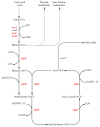Lactobacillus paracasei A13 and High-Pressure Homogenization Stress Response
- PMID: 32244939
- PMCID: PMC7143770
- DOI: 10.3390/microorganisms8030439
Lactobacillus paracasei A13 and High-Pressure Homogenization Stress Response
Abstract
Sub-lethal high-pressure homogenization treatments applied to Lactobacillus paracasei A13 demonstrated to be a useful strategy to enhance technological and functional properties without detrimental effects on the viability of this strain. Modification of membrane fatty acid composition is reported to be the main regulatory mechanisms adopted by probiotic lactobacilli to counteract high-pressure stress. This work is aimed to clarify and understand the relationship between the modification of membrane fatty acid composition and the expression of genes involved in fatty acid biosynthesis in Lactobacillus paracasei A13, before and after the application of different sub-lethal hyperbaric treatments. Our results showed that Lactobacillus paracasei A13 activated a series of reactions aimed to control and stabilize membrane fluidity in response to high-pressure homogenization treatments. In fact, the production of cyclic fatty acids was counterbalanced by the unsaturation and elongation of fatty acids. The gene expression data indicate an up-regulation of the genes accA, accC, fabD, fabH and fabZ after high-pressure homogenization treatment at 150 and 200 MPa, and of fabK and fabZ after a treatment at 200 MPa suggesting this regulation of the genes involved in fatty acids biosynthesis as an immediate response mechanism adopted by Lactobacillus paracasei A13 to high-pressure homogenization treatments to balance the membrane fluidity. Although further studies should be performed to clarify the modulation of phospholipids and glycoproteins biosynthesis since they play a crucial role in the functional properties of the probiotic strains, this study represents an important step towards understanding the response mechanisms of Lactobacillus paracasei A13 to sub-lethal high-pressure homogenization treatments.
Keywords: Lactobacillus paracasei; high-pressure homogenization; membrane fatty acid composition; stress response.
Conflict of interest statement
The authors declare no conflict of interest.
Figures


Similar articles
-
Effect of a sublethal high-pressure homogenization treatment on the fatty acid membrane composition of probiotic lactobacilli.Lett Appl Microbiol. 2014 Feb;58(2):109-17. doi: 10.1111/lam.12164. Epub 2013 Oct 15. Lett Appl Microbiol. 2014. PMID: 24111720
-
Microencapsulation of functional strains by high pressure homogenization for a potential use in fermented milk.Food Res Int. 2017 Jul;97:250-257. doi: 10.1016/j.foodres.2017.04.020. Epub 2017 Apr 18. Food Res Int. 2017. PMID: 28578048
-
Effect of a non-lethal High Pressure Homogenization treatment on the in vivo response of probiotic lactobacilli.Food Microbiol. 2012 Dec;32(2):302-7. doi: 10.1016/j.fm.2012.07.004. Epub 2012 Jul 27. Food Microbiol. 2012. PMID: 22986193
-
Probiotic Crescenza cheese containing Lactobacillus casei and Lactobacillus acidophilus manufactured with high-pressure homogenized milk.J Dairy Sci. 2008 Feb;91(2):500-12. doi: 10.3168/jds.2007-0516. J Dairy Sci. 2008. PMID: 18218736
-
Growth of Lactobacillus paracasei A13 in Argentinian probiotic cheese and its impact on the characteristics of the product.Int J Food Microbiol. 2009 Oct 31;135(2):171-4. doi: 10.1016/j.ijfoodmicro.2009.08.021. Epub 2009 Aug 24. Int J Food Microbiol. 2009. PMID: 19751954
Cited by
-
Antibiotic Resistance Carriage Causes a Lower Survivability Due to Stress Associated with High-Pressure Treatment among Strains from Starter Cultures.Animals (Basel). 2022 Jun 4;12(11):1460. doi: 10.3390/ani12111460. Animals (Basel). 2022. PMID: 35681924 Free PMC article.
-
High Homogenization Pressures to Improve Food Quality, Functionality and Sustainability.Molecules. 2020 Jul 21;25(14):3305. doi: 10.3390/molecules25143305. Molecules. 2020. PMID: 32708208 Free PMC article. Review.
-
Abrogating the adenine methylation ability of Lacticaseibacillus paracasei improves its freeze-drying and storage resistance.NPJ Sci Food. 2025 May 19;9(1):78. doi: 10.1038/s41538-025-00409-8. NPJ Sci Food. 2025. PMID: 40389488 Free PMC article.
-
Characterization of Autochthonous Strains from the Cecal Content of Creole Roosters for a Potential Use as Probiotics.Animals (Basel). 2023 Jan 28;13(3):455. doi: 10.3390/ani13030455. Animals (Basel). 2023. PMID: 36766343 Free PMC article.
-
Ribosome Profiling and RNA Sequencing Reveal Genome-Wide Cellular Translation and Transcription Regulation Under Osmotic Stress in Lactobacillus rhamnosus ATCC 53103.Front Microbiol. 2021 Nov 25;12:781454. doi: 10.3389/fmicb.2021.781454. eCollection 2021. Front Microbiol. 2021. PMID: 34899662 Free PMC article.
References
-
- Capra M.L. Effect of high pressure homogenization on lactic acid bacteria phages and probiotic bacteria phages. Int. Dairy J. 2009;19:336–341. doi: 10.1016/j.idairyj.2008.11.002. - DOI
-
- Patrignani F., Vannini L., Kamdem S.L.S., Lanciotti R., Guerzoni M.E. Effect of high pressure homogenization on Saccharomyces cerevisiae inactivation and physico-chemical features in apricot and carrot juices. Int. J. Food Microbiol. 2009;136:26–31. doi: 10.1016/j.ijfoodmicro.2009.09.021. - DOI - PubMed
-
- Lanciotti R., Patrignani F., Iucci L., Saracino P., Guerzoni M.E. Potential of high pressure homogenization in the control and enhancement of proteolytic and fermentative activities of some Lactobacillus species. Food Chem. 2007;102:542–550. doi: 10.1016/j.foodchem.2006.06.043. - DOI
LinkOut - more resources
Full Text Sources
Miscellaneous

